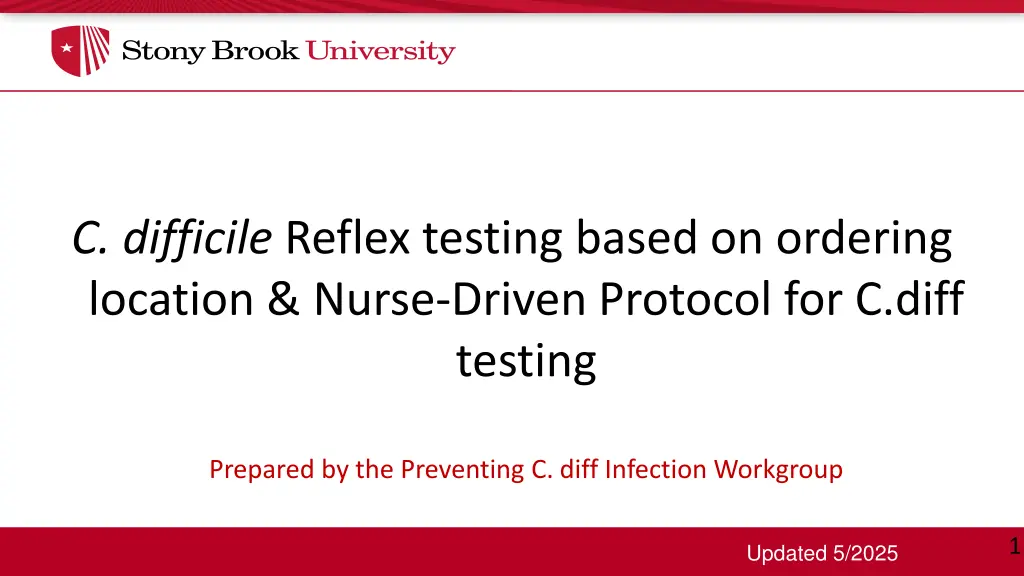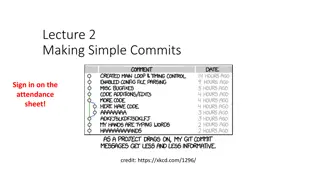
Understanding C. difficile Testing and Interpretation Protocols
Explore C. difficile reflex testing protocols, two-step testing algorithms, and interpretation recommendations for PCR and EIA results. Learn about CDI testing limitations and treatment guidelines.
Download Presentation

Please find below an Image/Link to download the presentation.
The content on the website is provided AS IS for your information and personal use only. It may not be sold, licensed, or shared on other websites without obtaining consent from the author. If you encounter any issues during the download, it is possible that the publisher has removed the file from their server.
You are allowed to download the files provided on this website for personal or commercial use, subject to the condition that they are used lawfully. All files are the property of their respective owners.
The content on the website is provided AS IS for your information and personal use only. It may not be sold, licensed, or shared on other websites without obtaining consent from the author.
E N D
Presentation Transcript
C. difficile Reflex testing based on ordering location & Nurse-Driven Protocol for C.diff testing Prepared by the Preventing C. diff Infection Workgroup 1 Updated 5/2025
Stony Brook uses a two-step testing algorithm including a PCR (polymerase chain reaction) and EIA (enzyme immunoassay) for all Inpatient and ED locations. The PCR test is highly sensitive for toxigenic genes. It cannot distinguish between active infection and asymptomatic carriage The EIA test has a lower sensitivity, but high specificity for the toxin production. It helps to determine an active infection or asymptomatic carriage. The EIA test will result after a +PCR result in PowerChart. Utilizing both PCR and EIA testing helps clinicians determine an appropriate treatment plan based on active infections or asymptomatic carriage. 2
Two-step testing protocol C. difficile toxin PCR (note: this is not available in the GI/diarrhea PCR panel) Positive PCR results are reflexed to a C. difficile toxin EIA CDI testing is limited to attending physicians if the patient has any of the following: 1. < 3 bowel movements documented in the EMR. 2. Recent laxative use in the past 48 hours. Retesting or within 14d of prior results is not indicated and unavailable. Stool specimens that are not liquid will be rejected by the laboratory. Test of cure contraindicated and not supported by IDSA-ASM guidelines. For specimens with patients suffering ileus or toxic megacolon please consult the Molecular Diagnostics Laboratory leadership for optimal testing algorithms. For this specimen type please consult with the Molecular Diagnostics Laboratory at x4-3747 3
How to Interpret your CD Test Results C. difficile PCR C. difficile EIA Interpretation Recommendations Initiate severity-based treatment (see Table 2) Stop concomitant acid suppressants and antibiotics if possible Enteric contact isolation Discontinue CDI treatment and isolation Stop concomitant acid suppressants and antibiotics if possible Evaluate for other possible causes of diarrhea Enteric contact isolation Stop concomitant acid suppressants and antibiotics if possible Treatment decisions should be individualized (see section 3) Positive Positive Likely CDI Negative Negative Not CDI Positive Negative May be CDI PCR + EIA Reflex Testing 4
* Rebyota and Vowst are not on the hospital formulary and are not available for inpatient use. Note that fidaxomicin use for the initial episode of CDI has been associated with a 16% relative risk reduction in recurrent CDI. However, this needs to be balanced with the high cost expense of fidaxomicin therapy compared to oral vancomycin, which may ultimately impact on patient adherence. The duration of vancomycin pulse taper regimens may vary depending on clinical factors. Consultation with ID or GI is recommended. PCR + EIA Reflex Testing 5
CDI Prevention and Prophylaxis Strategies for preventing CDI include the following: o Minimize antibiotic use o Avoid unnecessary gastric acid suppression Probiotics o The role of probiotics (i.e. Lactobacillus, Acidophilus) remains unclear. Results from clinical trials have been inconsistent. An increased risk of bacteremia has been noted in severely immunocompromised patients. National clinical guidelines from the IDSA and ACG do not support the use of probiotics. Vancomycin o Use of vancomycin as prophylaxis against CDI is controversial. Clinical data is limited to small studies that suggest a potential benefit in preventing CDI. However, this must be balanced with the known risk of disrupting the natural microbiome and driving microbial resistance (i.e. vancomycin-resistant Enterococci and multidrug resistant Enterobacteriaceae). o Vancomycin prophylaxis may be considered in the following high-risk groups with histories of severe CDI with at least two recurrent episodes of CDI: Age 65+ years of age Severely immunocompromised PCR + EIA Reflex Testing 6
Nurse Driven Protocol to detect symptomatic patients earlier resulting in reduced CDI-Hospital Onset (HO) categorization and reporting. Rule Triggers within Admission PowerPlans Stool documentation of 3 within 1 calendar day OR Stool description of Watery, Loose or Liquid within 1 calendar day AND Patient is 18 years of age Is an admitted inpatient Located on any adult unit (excluding Obstetrics and Pediatrics) Does not have an order of C.difficile PCR on their chart in either ordered or completed status Does not have a C.difficile result on their current hospital stay Has the order C.Diff when patient meets criteria on their chart (Located within admission powerplans) And it is before 11:59pm on the 3rd calendar day of current hospital stay (admit day =day 1) THEN C.difficile PCR routine order placed on patients' chart (signed by provider who placed the admission powerplan). The EIA test will result after a +PCR result in PowerChart. 7
Bristol Stool Form Scale *Lab accepts stools type 6 and higher. 8
1) C. Difficile When Patient Meets Criteria order in the Admission PowerPlan 2) Stool documentation criteria met @ 15:32 3) C. Difficile PCR order automatically placed @ 15:32 for Nurse or Provider Collect 10
Reminders Documentation of stools will trigger a C.diff test order if testing criteria are met; once test order triggers, patient is placed on isolation precautions and nurse is tasked to collect specimen. Reminder to collect specimen using a plastic device (i.e., spoon). Do not use a wood stick or cotton ball during collection because it can interfere with the PCR test and cause a false negative result. The provider ordering the admission PowerPlan will be the C. diff test ordering provider. Nurse Driven Protocol with laboratory order C. diff when patient meets criteria cancels on day three of admission. If specimen is not sent within 24 hours, the order is canceled by the system. Continue to round daily with team on stool description and count. 11






















